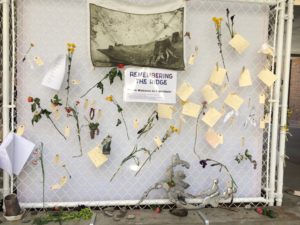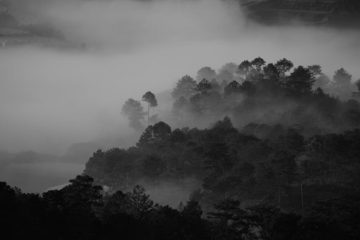Memorializing in the Aftermath of Disaster
Car keys dangled on the white chain link fence. A note next to them read “These keys made our lives so fabulous…Cars and a house—it’s time to say goodbye.” Nearby, other mementos included a singed cat collar; a photo of stumps where trees once stood, printed on cloth; melted pieces of glass and aluminum, transfigured by fire; and rocks with messages like “faith,” “hope,” and “love.” The burnt husk of a guitar had been placed on the corner of the fence.
This “Remembering the Ridge” memorial was constructed outside the library at California State University/Chico, at the heart of the college where I teach. It was inaugurated with a short ceremony, during which people wrote messages on stones and pieces of paper, arranged flowers on the fence, left offerings, wishes, and remnants of their lives before the fires in which 85 people died and over 18,000 structures were destroyed in the fall of 2018.

Spontaneous and temporary memorials have become an international idiom for public responses to large-scale tragedies: school shootings, terrorist attacks, and now wildfires. They appeared in Columbine, Colorado, after the 1999 school shootings, in New York City after the September 11, 2001 terrorist attacks, in Oslo after the 2011 terrorist attacks, in Charleston, South Carolina after the 2015 shootings at Emanuel African Methodist Episcopal Church, and most recently in Christchurch, New Zealand after the shootings at two mosques.
Since 1999, I have been studying these memorials, drawn to the outpourings of words and flowers that express what Erika Doss calls “the material culture of grief.” They offer a communal sacred space unconnected to faith or creed, a universal idiom of loss. But they are local too, specific and personal, with the names and stories of people who were killed. They move from the abstract, “we’ve all been impacted by the fire” to the specific: a cat’s collar, car keys. In “Remembering the Ridge,” there is something else: the memorialization of the nonhuman as well as the human. There are messages about beloved pets, photos of stumps and lone chimneys, thank you notes to cars that were burned up in the fire, elegies for homes that once offered warmth and comfort, now reduced to ash.
We invest things with meaning, both as we live and in our memorializing. We endow objects with agency, writing words like “hope” on stones so that others may take hope from them. Memorials interrupt the taken-for-granted quality of daily life, reminding us of rupture, tragedy, and the loss of these meaning-infused objects. They are a chance to pause. As Kate McCarthy, one of the Remembering Ridge speakers said, “standing here together we affirm what our ancestors have known in every time and culture. That a simple ceremony—placing a stone, observing silence—interrupts the pace of ordinary time that tells us to move on.”
Memorials transform private grief into public loss so that the larger community takes on the burden of grief. Those practicing ancient traditions, like those associated with the Mexican Day of the Dead, have always known that material objects help us navigate loss. Traditional colorful cemetery remembrances and home ofrendas (“offering” in Spanish) may serve as resources for more recent memorials. But new kinds of grief—school shootings and terrorist attacks—may also require new kinds of mourning.
Temporary and spontaneous memorials stitch together the personal sorrows of strangers, creating intimacy among them. An early example that literally stitched together individual stories was the The NAMES Project AIDS Memorial Quilt, started in 1987 in San Francisco. The Quilt consists of over 48,000 individual 3-by-6-foot memorial panels, most commemorating someone who died of AIDS, sewn together by friends and family.
Such memorials can have a contagious affect as those who visit them empathetically engage in the act of placing objects with ritualized focus and intention, of reading the messages of others and feeling their loss. People attending memorials grieve vicariously even if they did not personally lose a home or loved one. Ritual empathy works even from afar. Some people in our community supported the memorial installation but were not ready to be there. Yet they were glad it was happening, suggesting that such memorials can also do their “work” from a distance.
Beyond the local and the particular there may also be recognition of the larger context: Islamophobia, gun violence, white supremacy, climate change. In Chico, someone attached photos of a “Climate Uprising” demonstration amid the ashes of a burned home, evoking the climate change behind the local fires. In Christchurch, a poster reads, “Islamophobia will not be tolerated. We are all just humans.”
Memorializing is also a fraught process. James E. Young, a scholar involved with planning memorials, argues that memorials can be by dogged by “conflicting agendas,” particularly when the images are painfully reminiscent of local losses. “One of the best ideas proposed after September 11th,” Paul Goldberger wrote in the New Yorker, “was to preserve the twisted and burned shards of steel from the façade of the twin towers, but that seems to have been forgotten as if these relics were too specific or too painful.” The memorial that now stands replaces the wreckage with a new, pristine structure more abstract and open to interpretation.
Similarly, a proposal to commemorate Norway’s 2011 attack, “Memory Wound”—a stark channel cut through a peninsula near Utøya, where right wing extremist Anders Breivik fatally shot sixty-nine people—became too controversial and was never made. People in the area protested, not wanting to see a daily, unbearable reminder that amplified their pain. Young wonders in his book, The Stages of Memory: Reflections on Memorial Art, Loss, and the Spaces Between, “How to articulate a void without filling it in?” The cut would have highlighted the void left by the youth who were killed, not allowing the void to be filled but acting as a reminder of their lives and deaths.
Memorials allow for ongoing conversations with the dead, both people and our non-animate surroundings. Remembering brings what is lost back into relationship with us as much as it allows us to “move on.” Images of absence make what is lost present in the imagination or memory. A photo of stumps makes us think of both the loss of trees and what they once looked like. One Chico photograph includes before and after photos: on the left are shelves of bright green potted plants, on the right are the same shelves, twisted, burnt, and everything turned to grey. Another photo shows a blackened swing set, and another, an ash-covered foundation next to a burnt metal sign reading “home.” The 9/11 memorial in New York, “Reflecting Absence,” consists of two recessed pools built into the footprints of the Twin Towers. They remind us both of the Tower’s presence in the city’s sky and that those tall buildings and the people who worked in them are no longer.
#
Sarah M. Pike, Ph.D., is Professor of Comparative Religion and Chair of the Department of Comparative Religion and Humanities at California State University, Chico. She has written numerous articles and book chapters on contemporary Paganism, ritual, the New Age movement, the primitive skills movement, the Burning Man festival, spiritual dance, memorializing; environmental activism, and youth culture. Her most recent book is For the Wild: Ritual and Commitment in Radical Eco-Activism (University of California Press, 2017), an ethnographic study of radical environmental and animal rights activism, ritual, and youth culture.
This Counterpoint blog post may be reprinted with the following acknowledgement: “This article was published by Counterpoint Navigating Knowledge on 17 April 2019.”
The views and opinions expressed on this website, in its publications, and in comments made in response to the site and publications are those of the author(s) and do not necessarily reflect the views and opinions of Counterpoint: Navigating Knowledge, its founders, its staff, or any agent or institution affiliated with it, nor those of the institution(s) with which the author is affiliated. Counterpoint exists to promote vigorous debate within and across knowledge systems and therefore publishes a wide variety of views and opinions in the interests of open conversation and dialogue.




1 Comment
Counterpoint One Year On: Reflections and Experiences – Counterpoint: Navigating Knowledge · September 11, 2019 at 4:31 AM
[…] vision. These topics have ranged from the Anthropocene, queer theory, animal communication, and environmental mourning to nationalism(s), Chernobyl, science and religion, sexism, and human and animal rights. We have […]